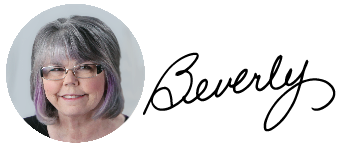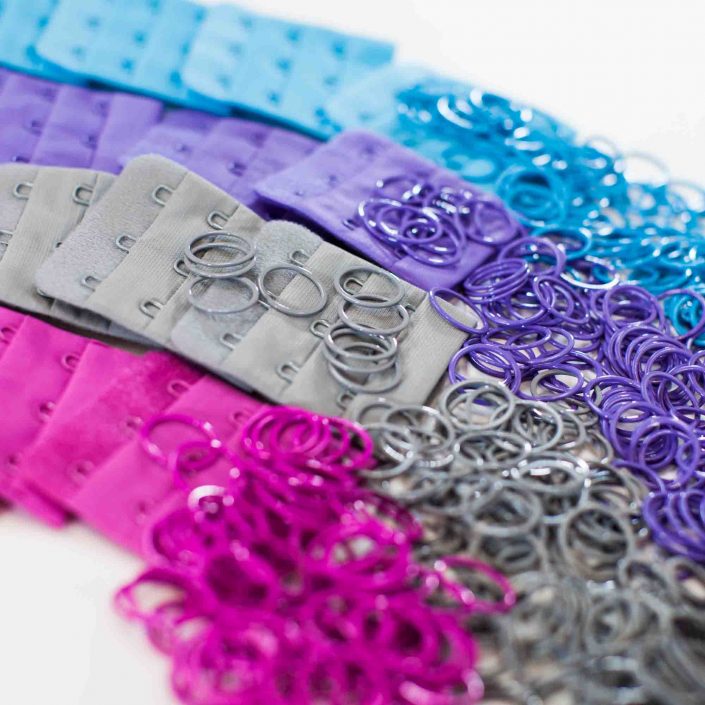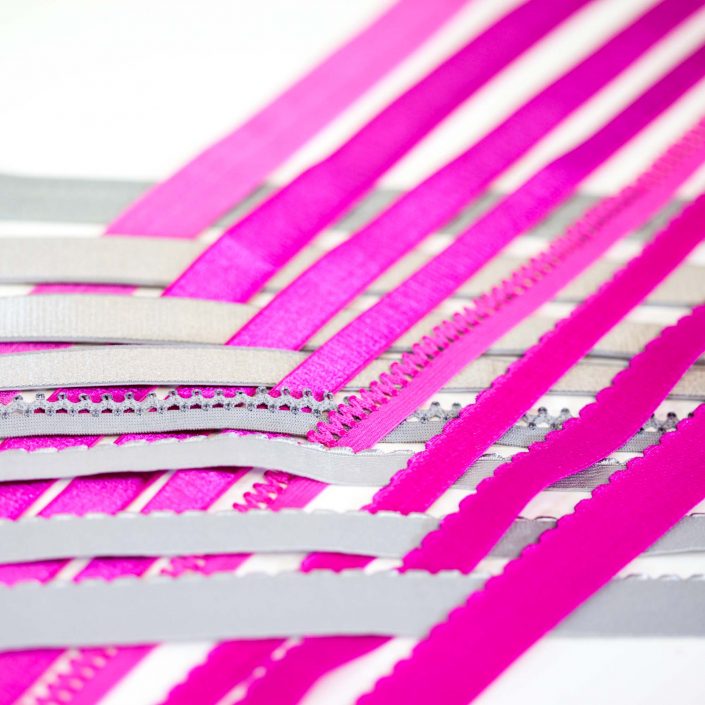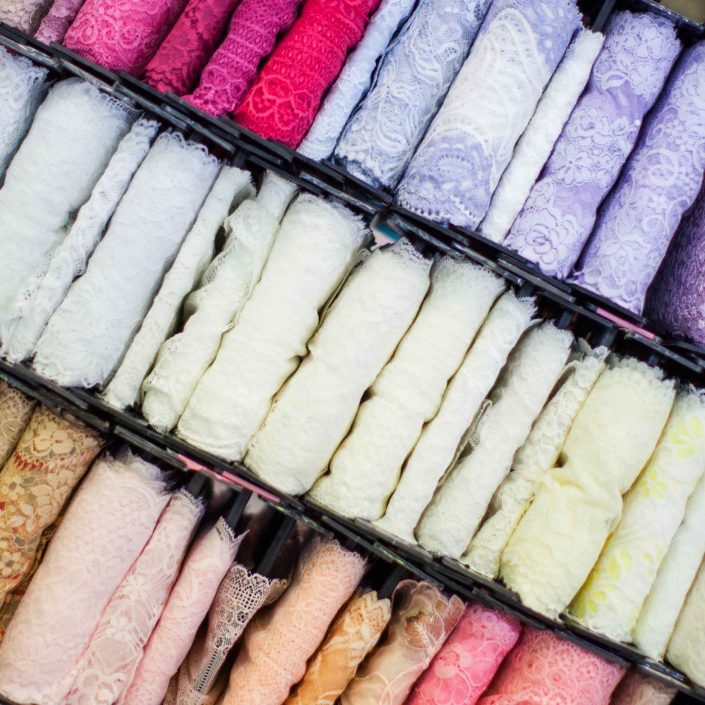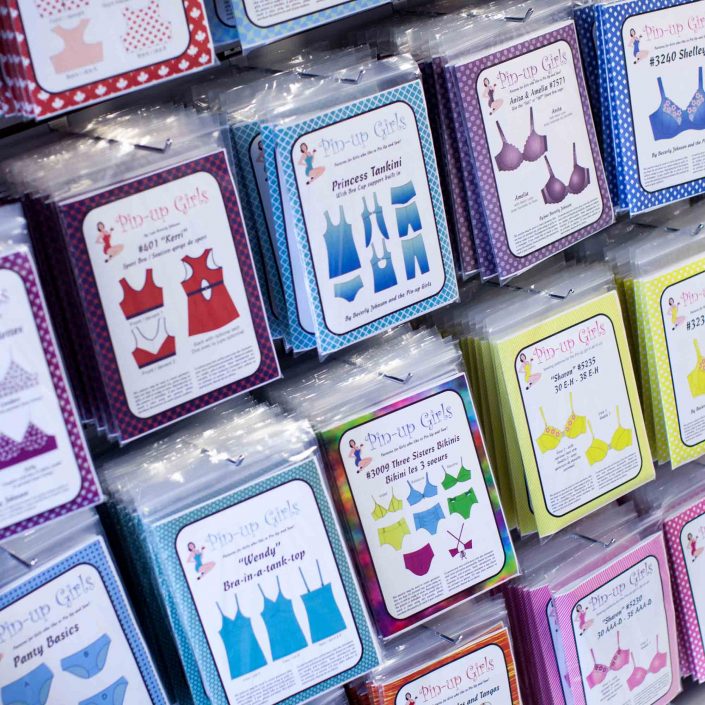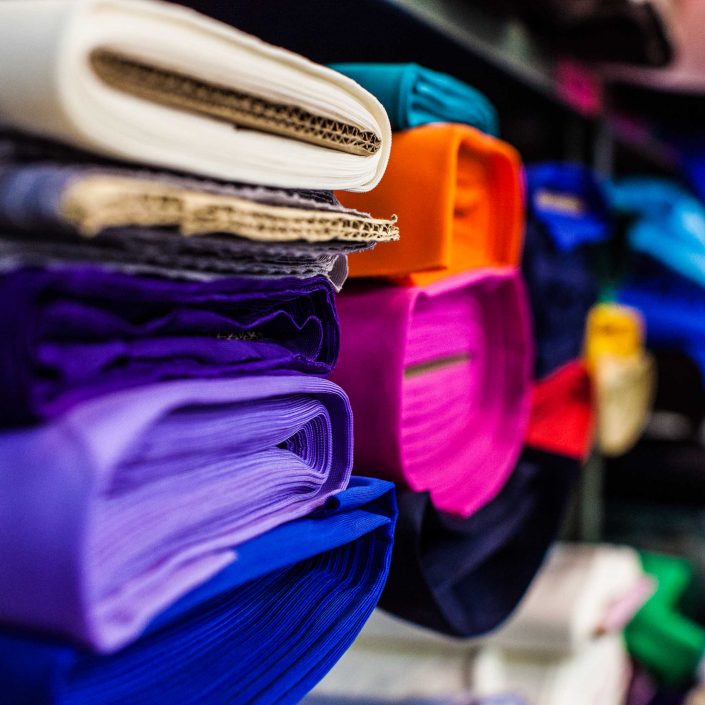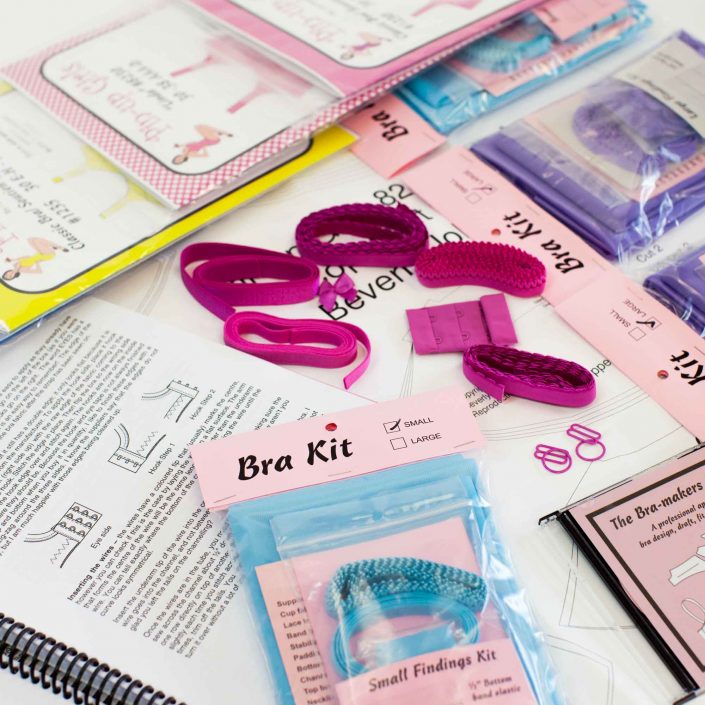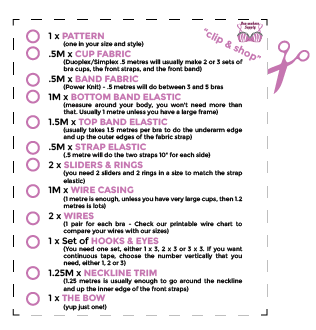The pattern I recommend for your first bra is the Classic Full Band Bra. A full band bra always has a band that runs under the cups and can be made with or without underwires. A partial band bra, however, must use underwires, as there is no band running under the cup. Underwires are needed for support.
Our most popular patterns are our “Pin-up Girls” line of bra patterns. The patterns fit well and are available in a range of 90 sizes! The Pin-up Girls Classic Full Band Bra Pattern with optional wires is available in four size ranges, with 90 unique bra sizes in all. Each size range has its own colour-coded packaging, with the Pink containing 30 sizes and the others each containing 20 sizes.
1230 (Pink) is a full band bra sizes 30-38 AAA – D
1235 (Yellow) is a full band bra sizes 30-38 E – H
1240 (Blue) is a full band bra sizes 40-48 A – D
1245 (Purple) is a full band bra sizes 40-48 E – H
We offer kits including the fabrics, elastics, and all the necessary findings – enough to make one bra (sometimes 2 depending on your size). The kits are available in 14 colours, which makes shopping much easier the first time around! Available colours include White, Ivory, Peach, Pink, Fuchsia, Red, Lilac, Turquoise, Navy Blue, Beige, Chocolate, Platinum, and Black. Everything on your bra-making supply list is included in the kit, except for the underwires.
If you would prefer to purchase components separately and customise your own bra in any way imaginable, this is the list of what you will need.
The bra band needs to go around the body and hook up in the back, therefore, the band fabric needs to have stretch. If the band is too stretchy, the band will ride up. Choose band fabrics that have a firm stretch, such as a Power Net or firm Stretch Spandex. There are several options and your choice will depend on your size or colours available.
The cup fabric on the other hand, has no need to stretch and is actually more supportive without it. Choose the cup fabric from no-stretch or low-stretch fabrics, such as Duoplex or the Simplex type of jersey knits. They do not contain spandex, and have only some “mechanical give”, which is a bit of give resulting from the knitting of the fabric. Once you perfect the fit of your bra, you can then experiment with different fabrics.
Two elastics are used for the band – one for the bottom of the band and one for the top, at the underarm edge. The bottom band elastic is the one that provides the support for the cups, therefore, is usually wider than the top elastic. Larger bra cups can use ¾” elastic, medium cups can use ⅝” or ½”, and smaller cups can easily use ⅜” elastic for the bottom band. The top band elastic is usually ⅜” wide, but if you have larger cups, you can use ½” at the top.
There are literally dozens of combinations of materials for straps. Some are all elastic, some are completely non-stretch, and some are a combination of both. You will find the best combination for you, after making a few bras. We recommend and include in the Classic bra pattern – the fabric from the cups (the non-stretch fabric) will make the front portion of the strap, which attaches to the front of the bra. The strap elastic will be at the back and it will include sliders and rings which will allow the straps to adjust. Straps that are wider or padded are great for large bra cups (¾”or wider), while a ½” to a ⅝” strap is good for medium cups. The smaller cups can use the ⅜” or spaghetti straps.
Even if you don’t use underwires, you should use wire casing around the cup. This keeps the bias edges from stretching out. Wire casing is also called ‘channelling’ or ‘wire tubing’, as it really is a tube. You always slide the wire inside the tube. If the wire is between the casing and the fabric, the wire will poke through the fabric. Which underwire size is right for you? Read the previous post for more information about wires.
Hooks and eyes are sold as pre-cut sets or as a continuous strip (such as found on a bustier). Each format has its own merits. We name the hooks and eyes by their number of vertical (up and down) hooks by the number of eyes available for adjusting. So a 2 x 3 hook and eye set is two hooks high and 3 eyes wide. Small cups can use 1 x 3, medium cups can use 2 x 3, and larger cups will feel supported with a 3 x 3 set. Some women even prefer 4 x 3 hooks and eyes for greater support.
The neckline trim is applied the uppermost edge of the bra, the decollete, if you will. The neckline trim finishes off the raw edge and if a narrow strip of stabiliser is stitched in under the trim, it will keep that edge from stretching out. This is absolutely necessary for larger cups. The neckline is also an area to show off some pretty trim!
Yes, the bow! That’s the finishing touch that makes the bra look like you just bought it. The bow is not only there to look pretty, it also hides the stitching for the closing of the wire casing.
Bra-making Supply List
Exactly what goes into a bra? If you are a first time bra-maker, the BIG LIST of “stuff” can be quite intimidating. Well you’ve come to the right place, this materials list will give you all the guidance you need to get started. Let’s go through the necessary bits and your Bra-making Supply List one by one. Once you understand why these materials are all needed, the list will not seem so long.
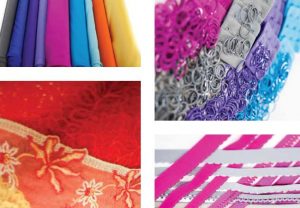
How much do you need to get shopping and be sure you have everything to make your bra?
Well…. ….Here’s bullet-list of all the bra-making supplies you need and the quantities you need.
- PATTERN – x 1
– one in your size - CUP FABRIC (Duoplex/Simplex) – x .5 metres
– .5 metres will usually make 2 or 3 sets of bra cups, the front straps, and the front band - BAND FABRIC (Power Net) – x .5 metres
– .3 metres will do between 3 and 5 bras - BOTTOM BAND ELASTIC – x 1 metre
– measure around your body, you won’t need more than that. Usually 1 metre unless you have a large frame - TOP BAND ELASTIC – x 1.5 metres
– usually takes 1.5 metres per bra to do the underarm edge and up the outer edges of the fabric strap - STRAP ELASTIC – x .5 metres
– .5 metre will do the two straps (10″ for each side) - SLIDERS & RINGS – x2 of each
– you need 2 sliders and 2 rings in a size to match the strap elastic - WIRE CASING – x1 metre
– 1 metre is enough, unless you have very large cups, then 1.2 metres is lots. - WIRES – x2 (1 pair for each bra)
– Check our printable wire chart to compare your wires with our sizes. - HOOKS & EYES – x1 set
– You need one set, either 2 x 3 or 3 x 3. If you want continuous tape, choose the number vertically that you need, either 2 or 3. - NECKLINE TRIM – x 1.25 metres
– 1.25 metres is usually enough to go around the neckline and up the inner edge of the front straps. - THE BOW – x1
– just one!
Other Essentials (equipment)
- Thread
-Regular polyester threads work fine! We carry mara 120 Guterman Industrial quality thread on 1000 metre spools. Great thread for making fine stitches at a great price. - Machine
– A zigzag machine is a must, and one that is capable of a three-step zigzag is desirable. If a three-step zigzag is not available, regular zigzag will do. - Needle
– Treat your machine to a new Schmetz needle. Use a ballpoint 70 on Simplex or jersey jacquard, or Duoplex (or other fabrics that are knitted but do not have spandex in them). If you have a problem with skipped stitches especially on Power net, switch the needle to a Universal 14. On spandex blend fabrics such as Raschels or tricots, you should always use the Stretch needle.
It also includes this handy “clip & shop” guide that you can use to check-off your bra items while shopping on our website or in your local community.
As always I love to hear from you, whether you have questions or comments be sure to write me below, I always get back to everyone as soon as I can. Don’t forget to subscribe to my blog by putting your email address in one of the “subscribe” boxes on either side of this blog post.
*HUGS* from your Fairy Bra Mother
